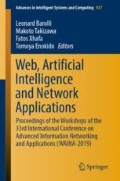Abstract
A chatbot can be defined as a computer program, designed to interact with users using natural language or text in a way that the user thinks he is having dialogue with a human. Most of the chatbots utilise the algorithms of artificial intelligence (AI) in order to generate required response. Earlier chatbots merely created an illusion of intelligence by employing much simpler pattern matching and string processing design techniques for their interaction with users using rule-based and generative-based models. However, with the emergence of new technologies more intelligent systems have emerged using complex knowledge-based models. This paper aims to discuss chatbots classification, their design techniques used in earlier and modern chatbots and how the two main categories of chatbots handle conversation context.
Access this chapter
Tax calculation will be finalised at checkout
Purchases are for personal use only
References
Zadrozny, W., et al.: Natural language dialogue for personalized interaction. Commun. ACM 43(8), 116–120 (2000)
Hussain, S., Athula, G.: Extending a conventional chatbot knowledge base to external knowledge source and introducing user based sessions for diabetes education. In: 2018 32nd International Conference on Advanced Information Networking and Applications Workshops (WAINA) 2018. IEEE
Levesque, H.J.: Common sense, the turing test, and the quest for real AI: Reflections on Natural and Artificial Intelligence. MIT Press, Cambridge (2017)
Wikipedia: Chatbot. 29 December 2018 (cited 30 December 2018). https://en.wikipedia.org/wiki/Chatbot
Weizenbaum, J.: ELIZA–a computer program for the study of natural language communication between man and machine. Commun. ACM 26(1), 23–28 (1983)
Wikipedia. Artificial Linguistic Internet Computer Entity. 19 November 2018 (cited 30 December 2018). https://en.wikipedia.org/wiki/Artificial_Linguistic_Internet_Computer_Entity
Wallace, R.S.: The anatomy of ALICE. In: Parsing the Turing Test, pp. 181–210. Springer, Dordrecht (2009)
Ramesh, K., et al.: A Survey of Design Techniques for Conversational Agents. In: International Conference on Information, Communication and Computing Technology. Springer, Singapore (2017)
Budulan, S.: Chatbot Categories and Their Limitations (2018). (cited May 2018). https://dzone.com/articles/chatbots-categories-and-their-limitations-1
Chen, H., et al.: A Survey on Dialogue Systems: Recent Advances and New Frontiers (2017). arXiv preprint arXiv:1711.01731
Yan, Z., et al.: Building Task-Oriented Dialogue Systems for Online Shopping. In: AAAI (2017)
Masche, J., Le, N.-T.: A Review of Technologies for Conversational Systems. In: International Conference on Computer Science, Applied Mathematics and Applications. Springer, Cham (2017)
Abdul-Kader, S.A., Woods, J.: Survey on chatbot design techniques in speech conversation systems. Int. J. Adv. Comput. Sci. Appl. 6(7), 72–80 (2015)
Mathur, V., Singh, A.: The Rapidly Changing Landscape of Conversational Agents (2018). arXiv preprint arXiv:1803.08419
Bradeško, L., Mladenić, D.: A survey of chatbot systems through a loebner prize competition. In: Proceedings of Slovenian Language Technologies Society Eighth Conference of Language Technologies (2012)
Weizenbaum, J.: ELIZA—a computer program for the study of natural language communication between man and machine. Commun. ACM 9(1), 36–45 (1966)
Clarke, D.: Three AI Technologies that could make chatbots intelligent. 24 March 2018 (cited 18 December 2018). https://hackernoon.com/three-ai-technologies-that-could-make-chatbots-intelligent-10f8c6e8b4b0
Shawar, B.A., Atwell, E.: Chatbots: are they really useful? Zeitschrift für Computerlinguistik und Sprachtechnologie, p. 29 (2007)
Wikipedia contributors. ChatScript. Wikipedia, The Free Encyclopedia. 4 September 2018, 19:19 UTC. https://en.wikipedia.org/w/index.php?title=ChatScript&oldid=858055386. Accessed 22 Jan 2019
Robino, G.: How to build your first chatbot using Chatscript (2018). (cited 18 December 2018). https://medium.freecodecamp.org/chatscript-for-beginners-chatbots-developers-c58bb591da8
Milward, D., Beveridge, M.: Ontology-based dialogue systems. In: Proceedings of 3rd Workshop on Knowledge and reasoning in practical dialogue systems (IJCAI 2003) 2003
Al-Zubaide, H., Issa, A.A.: Ontbot: Ontology based chatbot. In: 2011 Fourth International Symposium on Innovation in Information & Communication Technology (ISIICT). IEEE (2011)
Nuez Ezquerra, A.: Implementing ChatBots using Neural Machine Translation Techniques (2018). Universitat Politècnica de Catalunya
Csáky, R.: Deep Learning Based Chatbot Models (2017). https://doi.org/10.13140/rg.2.2.21857.40801
Pelk, H.: Machine learning, neural networks and algorithms (2016). (cited 18 January 2019). https://itnext.io/machine-learning-neural-networks-and-algorithms-4cd27a105b89
Wikipedia contributors. Artificial neural network. In: Wikipedia, The Free Encyclopedia. https://en.wikipedia.org/w/index.php?title=Artificial_neural_network&oldid=878429976. Accessed 13:24, 25 Jan 2019
Young, T., et al.: Recent trends in deep learning based natural language processing. IEEE Comput. Intell. Mag. 13(3), 55–75 (2018)
Cahn, J.: CHATBOT: Architecture, design, and development. In: University of Pennsylvania School of Engineering and Applied Science Department of Computer and Information Science (2017)
Cho, K., et al.: Learning phrase representations using RNN encoder-decoder for statistical machine translation (2014). arXiv preprint arXiv:1406.1078
Sak, H., Senior, A., Beaufays, F.: Long short-term memory recurrent neural network architectures for large scale acoustic modeling. In: Fifteenth Annual Conference of the International Speech Communication Association (2014)
Ji, Z., et al.: An information retrieval approach to short text conversation (2014). arXiv preprint. arXiv:1408.6988.1
Duijst, D., Sandberg, J., Buzzo, D.: Can we Improve the User Experience of Chatbots with Personalisation? (2017)
Liu, B., Xu, Z., Sun, C., Wang, B., Wang, X., Wong, D.F., Zhang, M.: Content-oriented user modeling for personalized response ranking in Chatbots. IEEE/ACM Trans. Audio Speech Lang. Process. (2018)
Pilato, G., Augello, A., Gaglio, S.: A modular architecture for adaptive ChatBots. In: Proceedings of 5th IEEE International Conference on Semantic Computing, ICSC 2011 (2011)
Vtyurina, A., Savenkov, D., Agichtein, E., Clarke, C.L.A.: Exploring conversational search with humans, assistants, and wizards. In: Proceedings of the 2017 CHI Conference Extended Abstracts on Human Factors in Computing Systems – CHI EA 2017 (2017)
Niculescu, A.I., Banchs, R.E.: Strategies to cope with errors in human-machine spoken interactions: using chatbots as back-off mechanism for task-oriented dialogues. In: Errors by Humans Mach. multimedia, multimodal Multiling, Data Process (2015)
Author information
Authors and Affiliations
Corresponding author
Editor information
Editors and Affiliations
Rights and permissions
Copyright information
© 2019 Springer Nature Switzerland AG
About this paper
Cite this paper
Hussain, S., Ameri Sianaki, O., Ababneh, N. (2019). A Survey on Conversational Agents/Chatbots Classification and Design Techniques. In: Barolli, L., Takizawa, M., Xhafa, F., Enokido, T. (eds) Web, Artificial Intelligence and Network Applications. WAINA 2019. Advances in Intelligent Systems and Computing, vol 927. Springer, Cham. https://doi.org/10.1007/978-3-030-15035-8_93
Download citation
DOI: https://doi.org/10.1007/978-3-030-15035-8_93
Published:
Publisher Name: Springer, Cham
Print ISBN: 978-3-030-15034-1
Online ISBN: 978-3-030-15035-8
eBook Packages: Intelligent Technologies and RoboticsIntelligent Technologies and Robotics (R0)

